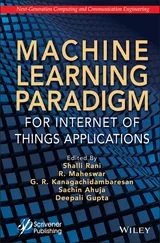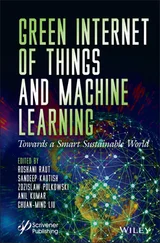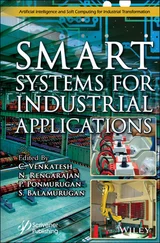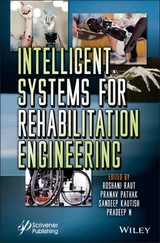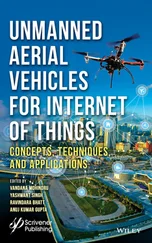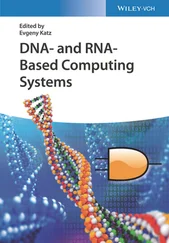Trust-Based Communication Systems for Internet of Things Applications
Здесь есть возможность читать онлайн «Trust-Based Communication Systems for Internet of Things Applications» — ознакомительный отрывок электронной книги совершенно бесплатно, а после прочтения отрывка купить полную версию. В некоторых случаях можно слушать аудио, скачать через торрент в формате fb2 и присутствует краткое содержание. Жанр: unrecognised, на английском языке. Описание произведения, (предисловие) а так же отзывы посетителей доступны на портале библиотеки ЛибКат.
- Название:Trust-Based Communication Systems for Internet of Things Applications
- Автор:
- Жанр:
- Год:неизвестен
- ISBN:нет данных
- Рейтинг книги:4 / 5. Голосов: 1
-
Избранное:Добавить в избранное
- Отзывы:
-
Ваша оценка:
- 80
- 1
- 2
- 3
- 4
- 5
Trust-Based Communication Systems for Internet of Things Applications: краткое содержание, описание и аннотация
Предлагаем к чтению аннотацию, описание, краткое содержание или предисловие (зависит от того, что написал сам автор книги «Trust-Based Communication Systems for Internet of Things Applications»). Если вы не нашли необходимую информацию о книге — напишите в комментариях, мы постараемся отыскать её.
Highlighting the challenges and difficulties in implementing trust-based communication systems for Internet of Things (IoT) services and applications, this innovative new volume is a critical reference source for academics, professionals, engineers, technology designers, analysts, and students.
Trust-Based Communication Systems for Internet of Things Applications — читать онлайн ознакомительный отрывок
Ниже представлен текст книги, разбитый по страницам. Система сохранения места последней прочитанной страницы, позволяет с удобством читать онлайн бесплатно книгу «Trust-Based Communication Systems for Internet of Things Applications», без необходимости каждый раз заново искать на чём Вы остановились. Поставьте закладку, и сможете в любой момент перейти на страницу, на которой закончили чтение.
Интервал:
Закладка:
Table of Contents
1 Cover
2 Title Page Scrivener Publishing 100 Cummings Center, Suite 541J Beverly, MA 01915-6106 Publishers at Scrivener Martin Scrivener ( martin@scrivenerpublishing.com ) Phillip Carmical ( pcarmical@scrivenerpublishing.com )
3 Copyright
4 Preface
5 Book Description
6 1 An Analysis of the Internet of Things (IoT) as the Defining Technology of a Generation
1.1 Introduction 1.1 Introduction The IoT is an integrated system that looks at material with different levels of processing, hearing, and performance sharing that communicates as their integrated Internet platform as shown in Figure 1.1 . The main purpose of the IoT, therefore, is to make things connected to other things and people, using any network, route, or service, anytime, anywhere. Figure 1.1 IoT. The IoT is increasingly being considered the next step in the evolution of the Internet. Devices such as Smartphones, cars, industrial systems, cameras, toys, buildings, household items, industrial systems, and countless others can exchange information via the Internet these days. These devices can perform fine-tuning, tracking, setting, control, real-time monitoring, and process control regardless of their size and functions [1]. The widespread proliferation of Internet-enabled devices has taken place in recent years.
1.2 Growth of IoT 1.2 Growth of IoT The Internet certainly become a part of the life of a social animal. It is a big room for people and knowledge. The Internet first emerged as the “Computer Internet.” It is a digital network where it is possible to incorporate several services on top of it, such as the World Wide Web. It was an age of information sharing. There were several social websites that kept individuals linked all the time. This has led to the Internet being loaded with individuals rather than data. Technology, on the other hand, has been progressing day by day. A period of “MobiComp” (mobile computing) has also begun [2–4]. Mobile internet services for 3G and 4G have now resulted in quicker internet connectivity and increased video call quality. Mobile computing and wireless technology have become inexpensive and have gained more popularity. Therefore, there was a new computer-Ubiquitous computing. Figure 1.2 Growth of Internet of Things. Intelligent space and minimal user participation are the subjects of this computing. Advances in technology have contributed to a reduction in size for smartphones and other portable devices. Ordinary mobiles and PCs have been replaced by smart phones, i-pads, laptops, and notebooks. There was also a shift in the device through which individuals access the internet. This, in turn, resulted in the configuration of sophisticated functions. Devices were not only connected to the internet in such a situation, but also sensed, computed, and performed intelligent tasks. Later, physical items were programmed with identification tags such as bar code and RFID so that devices such as smart phones could scan them and upload their information to the internet. With the aid of a smart computer, this way of linking the real world with cyberspace contributed to the internet being called the “Internet of Things”. Figure 1.2 shows that it has its origins in mobile computing, ubiquitous computing, and IT [5]. Therefore, from the above, IoT transforms the view of connectivity from “any-time, anywhere” for “anyone” to “any-time,” any-place” for “any-thing”.
1.3 IoT Technologies 1.3 IoT Technologies These components are essential for the deployment of IoT-based devices: 1 i) RFID: It is a tiny chip that receives signals. It helps us to use radio waves, tags, and readers for direct automatic identification and date capture. Depending on whether power supplies are available or not, RFID tags may be passive or active. 2 ii) WSN: This is a network of autonomous sensors distributed in space. Their function is to monitor the status of RFID objects’ position, temperature, motion, etc. A sensor network’s sensing nodes transmit data to their sinks. 3 iii) Middleware: Designing of a software to hide the complexities of various technologies and make communication friendly. This architecture is termed as service-oriented architecture. 4 iv) Cloud & Fog Computing: It is a computing model for accessing the on-demand pool of computers, networks, servers, storage, databases, utilities, software, etc. There are several problems with IoT cloud computing, including synchronization, standardization, balancing, reliability, and management. The extension of cloud computing services to the vicinity of users has improved efficacy with the assistance of fog computation. Fog computation includes characteristics such as location, distribution, scalability, support for mobility, interactive real-time services, and fly analysis [6]. 5 v) IoT Application Software: Piece of code for the development of various industry-oriented applications. All services are provided for the same reason.
1.4 Application Areas of Internet of Things 1.5 IoT Security and Protection Concerns 1.6 IoT Security 1.7 Conclusion References
7 2 Blockchain in IoT and Limitations 2.1 Introduction 2.2 Literature Review 2.3 Limitations of Blockchain 2.4 Conclusion References
8 3 IoT Protocol Security Mechanisms 3.1 Introduction 3.2 Comparing to IoT Security and Cyber-Physical Structures 3.3 Potential IoT and the Need for Safety 3.4 Future-Cognitive Structures and IoT 3.5 Security Engineering for IoT Development 3.6 Building Security into Design and Development 3.7 Security in Agile Developments 3.8 Focusing on the IoT Device in Operation 3.9 IoT Security Innovation Cryptographic Basics 3.10 Cryptographic Primitive Forms and Implementations in the IoT 3.11 Encryption and Decryption 3.12 Hashes 3.13 Digital Signatures 3.14 Generation of Random Numbers 3.15 Cloud Security for IoT 3.16 Control of Assets/Inventories Conclusion References
9 4 IoT Security, Privacy, Challenges, and Solutions 4.1 Introduction 4.2 IoT Landscape: Current and Potential Applications 4.3 Advantages of Internet of Things (IoT) 4.4 Architecture of IoT Systems 4.5 IoT Security 4.6 Security Challenges in IoT Architecture 4.7 Security by Design in IoT 4.8 Best Practices to Secure IoT Devices 4.9 Security Attacks in IoT System 4.10 Various IoT Security Challenges 4.11 Limitations of Available Resources 4.12 Solutions to Preserve Privacy in IoT Systems Conclusions References
10 5 CIA-CPS: Concept, Issues, and Application of IoT in Cyber Physical System 5.1 Introduction 5.2 Cyber Physical System: Definition 5.3 System Interfaces 5.4 Communication Channel 5.5 Physical Interaction 5.6 CPS vs IoT 5.7 Cyber Physical System Issues 5.8 Literature Survey 5.9 Applications of Cyber Physical System 5.10 Future of Cyber Physical Systems 5.11 Conclusion References
11 6 Trust Calculation in IoT Nodes Without Trusted Third Party Using PUF Methodology 6.1 Introduction 6.2 Related Works 6.3 Trust Calculation Basics 6.4 Deriving Trust Relationships 6.5 Trust Derivation Examples 6.6 Combination of Trust Relationship 6.7 Analysis of Attacks 6.8 Conclusions References
12 7 Comparative Analysis of Indexing Schemes Used in Cloud Computing Data Management 7.1 Introduction 7.2 Literature Review 7.3 Overview of System Architecture 7.4 Experiments and Comparison 7.5 Database for Experiment 7.6 Assessment of the Index Structure 7.7 Performance Evaluation of Exact Search 7.8 Evaluation of Indexing Schemes Based on k-Nearest Neighbor Search 7.9 Evaluation of Data Distribution 7.10 Conclusion References
13 8 Evolution and Insight in Industrial Internet of Things (IIoT): Importance and Impact 8.1 Introduction 8.2 An Efficient Approach Towards IIoT Technology 8.3 Evolution of IIoT 8.4 IIoT Architecture 8.5 Industrial Applications of IoT 8.6 Smart Manufacturing 8.7 Smart Healthcare 8.8 Smart Transportation 8.9 Smart Cities 8.10 Oil and Gas Industry 8.11 Logistics and Supply Chain 8.12 Basic Technologies of IIoT 8.13 Things Over Internet 8.14 Technology on Blockchain 8.15 Computing of Data Over Cloud Technology 8.16 Artificial Intelligence and Cyber Physical Systems 8.17 Analytics on Management of Big Data 8.18 Future Technologies: Augmented and Virtual Reality 8.19 Industry 4.0 8.20 Research Challenges 8.21 Conclusions References
Читать дальшеИнтервал:
Закладка:
Похожие книги на «Trust-Based Communication Systems for Internet of Things Applications»
Представляем Вашему вниманию похожие книги на «Trust-Based Communication Systems for Internet of Things Applications» списком для выбора. Мы отобрали схожую по названию и смыслу литературу в надежде предоставить читателям больше вариантов отыскать новые, интересные, ещё непрочитанные произведения.
Обсуждение, отзывы о книге «Trust-Based Communication Systems for Internet of Things Applications» и просто собственные мнения читателей. Оставьте ваши комментарии, напишите, что Вы думаете о произведении, его смысле или главных героях. Укажите что конкретно понравилось, а что нет, и почему Вы так считаете.


